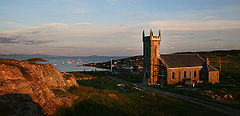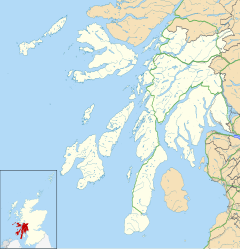Human settlement in Scotland
Arinagour
| |
|---|---|
 View over Arinagour and Arinagour Bay View over Arinagour and Arinagour Bay | |
 | |
| Population | 50 (approximate) |
| OS grid reference | NM2257 |
| Council area | |
| Lieutenancy area | |
| Country | Scotland |
| Sovereign state | United Kingdom |
| Post town | ISLE OF COLL |
| Postcode district | PA78 |
| Dialling code | 01879 |
| Police | Scotland |
| Fire | Scottish |
| Ambulance | Scottish |
| UK Parliament | |
| Scottish Parliament | |
| 56°37′N 6°32′W / 56.62°N 6.53°W / 56.62; -6.53 | |
Arinagour (Scottish Gaelic: Àirigh nan Gobhar, "shieling of the goats") is a village on the island of Coll, in the Argyll and Bute council area of Scotland. It is the main settlement on the island, and is the island's ferry terminal. It has a population of around 50.
History
Arinagour has been a site of human activity since prehistoric times as evidenced by a standing stone located by the shore.
In 1961 it had a population of 54.
Buildings
Arinagour parish church is a Gothic Revival Church, with a timber roof and lancet windows, that was built in 1907.
Arinagour Free Church was built circa 1880, with a belcote and pointed arch windows it became disused in 2008.
There is a First World War and Second World War memorial in Arinagour, on Shore Street, in the form of a small standing stone with a memorial plaque to those locals who died in the wars.
Education
Arinagour Primary School is located in the village and was built in 1954. In 2022, it was reported as having only 6 pupils.
Transport
Coll's ferry terminal is located on the edge of Arinagour. It is a staffed location, with a pier, vehicle assembly area, passenger facilities and some public moorings. The harbour and pier are also used by leisure craft and small cruise ships.
A ferry operated by Caledonian MacBrayne crosses to Oban and Tiree daily, extending once a week to Castlebay on Barra.
References
- "Ainmean-Àite na h-Alba". 28 July 2020.
- "Arinagour: Overview". Gazetteer for Scotland. Retrieved 21 December 2017.
- "Arinagour". Visit Coll. Retrieved 7 January 2021.
- Historic Environment Scotland. "Coll, Arinagour (272252)". Canmore. Retrieved 1 October 2024.
- "Arinagour". Gazetteer for Scotland. Retrieved 14 July 2019.
- Historic Environment Scotland. "Coll, Arinagour, Coll Parish Church (145902)". Canmore. Retrieved 1 October 2024.
- Historic Environment Scotland. "Coll, Arinagour, Free Church (295118)". Canmore. Retrieved 1 October 2024.
- Historic Environment Scotland. "Coll, Arigagour, Shore Street, War Memorial (340804)". Canmore. Retrieved 1 October 2024.
- "Island of Coll". Imperial War Museums. Retrieved 1 October 2024.
- Council, Bute. "Arinagour Primary School". Argyll and Bute Council. Retrieved 1 October 2024.
- McConnell, Stewart (17 August 2022). "Teacher's 'fairytale' after quitting mainland for life on sleepy island of Coll". Daily Record. Retrieved 1 October 2024.
- ^ "Coll: Arinagour". CMAL Caledonian Maritime Assets Ltd. 21 April 2023. Retrieved 1 October 2024.
- "Harbour Operations Information". CalMac Ferries. Retrieved 1 October 2024.